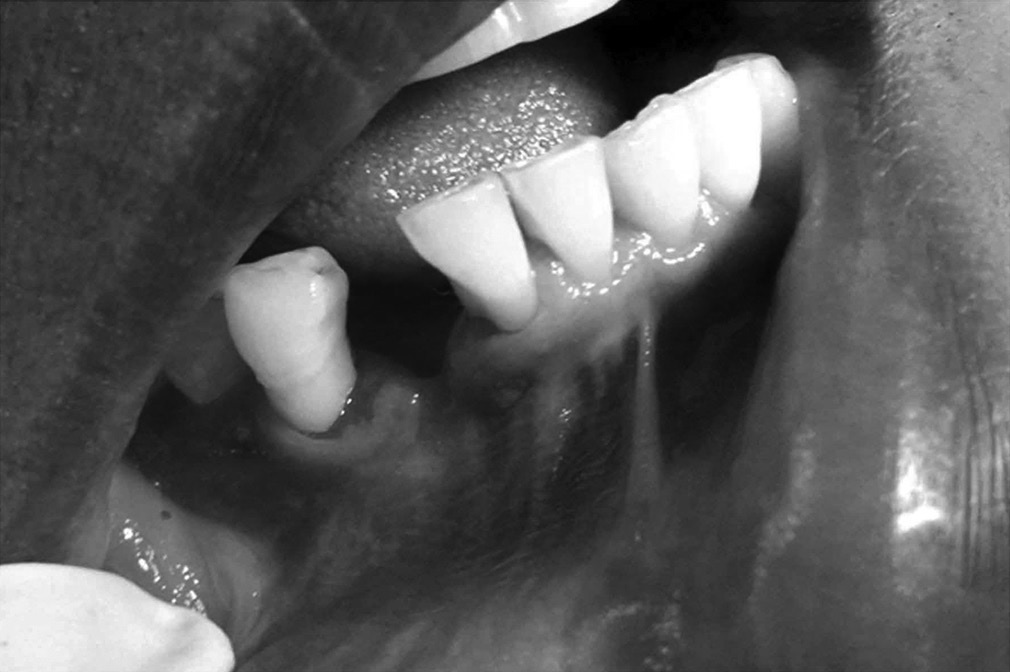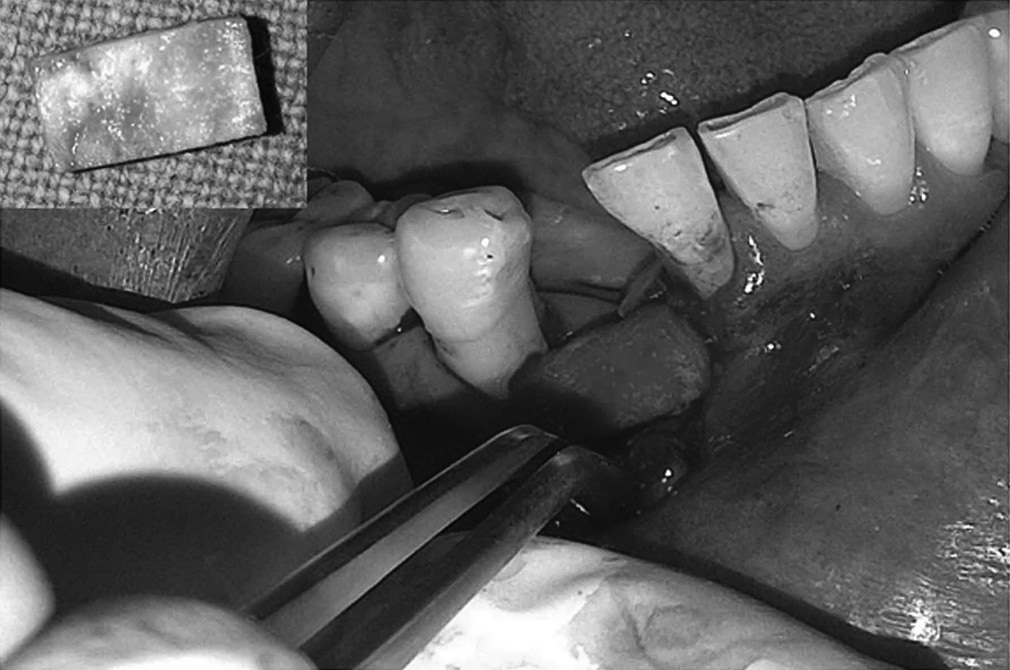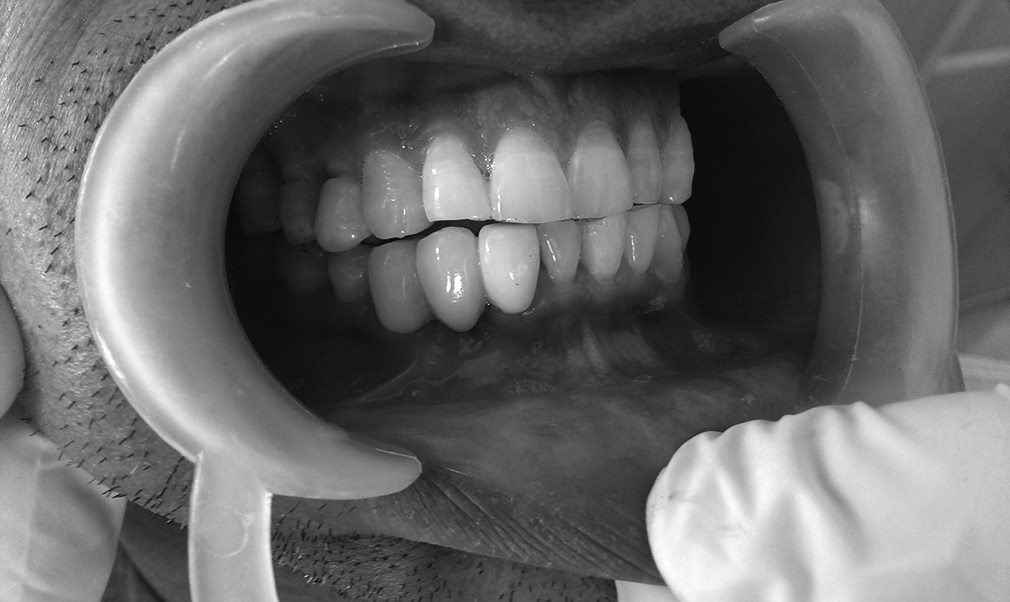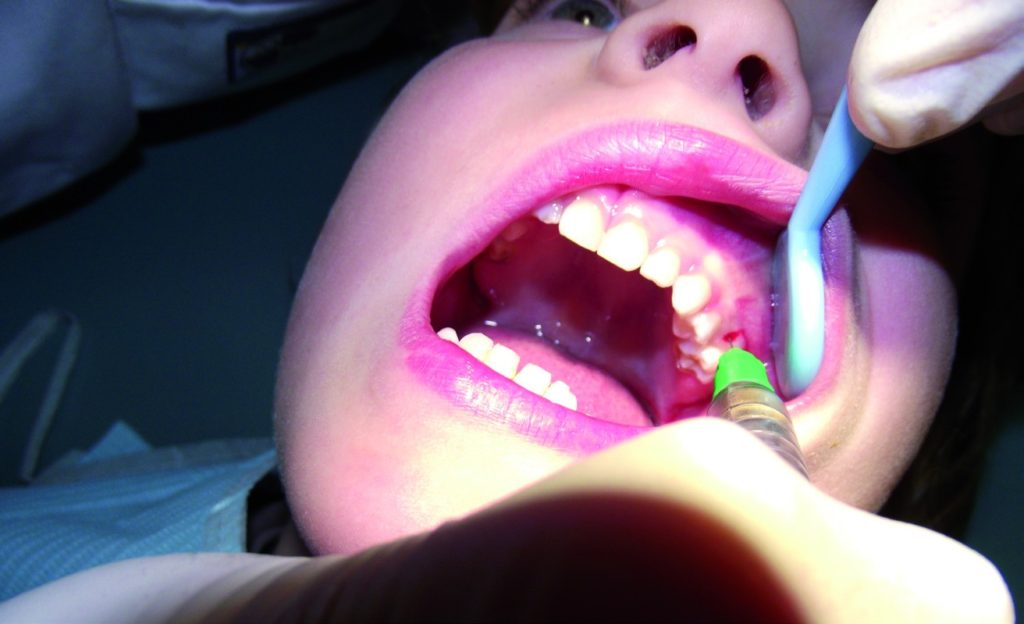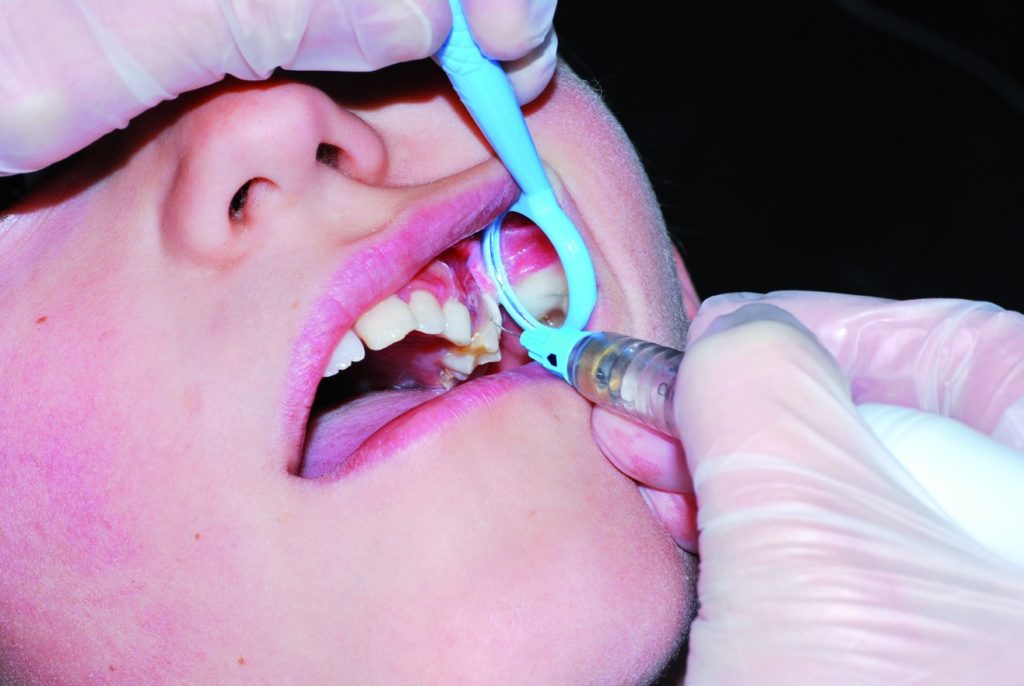W nagłych wypadkach stomatologicznych, zastosowanie znieczulenia miejscowego do leczenia bólu o pochodzeniu endodontycznym wykazuje coraz wyższy odsetek niepowodzeń. Zespół Oddziału Stomatologii Odtwórczej i Endodontyki Szpitala Uniwersyteckiego w Marsylii zakończył prospektywne badania kliniczne w celu oceny skuteczności znieczulenia transkortykalnego za pomocą systemu QuickSleeper® po niepowodzeniu w zastosowaniu znieczulenia klasycznego.
Leczenie bólu w zarządzaniu nagłymi wypadkami stomatologicznymi jest wyzwaniem dla klinicysty, szczególnie, gdy ból ten jest związany z patologią endodontyczną. W rzeczywistości, jeśli znieczulenie miejscowe (blokada nerwu zębodołowego dolnego przy otworze żuchwowym) daje bardzo dobre wyniki w odniesieniu do planowanej opieki dentystycznej na zębie bezobjawowym, ze wskaźnikiem skuteczności wahającym się od 75 do 90% (1), wskaźnik niepowodzenia tych samych środków znieczulających istotnie wzrasta w przypadku nieodwracalnego zapalenia miazgi lub tkanek okołowierzchołkowych. Stąd też, badania kliniczne wykazały, że znieczulenie w postaci samej blokady IAN było nieskuteczne w 30 do 80% przypadków po zdiagnozowaniu zapaleniu miazgi na zębach trzonowych żuchwy (2, 3, 4).
Sformułowano kilka założeń mających na celu wyjaśnienie mechanizmów tych niepowodzeń (5), między innymi:
- zmiany anatomiczne i kompleksowość unerwienia zęba;
- zjawisko tachyfilaksji (redukcja odpowiedzi na substancję farmakologiczną związana z poprzednią iniekcją tej samej substancji);
- wpływ zapalenia na pH otoczenia; kwasica zapalna w tkankach utrzymuje wysoki odsetek cząsteczek znieczulenia w formie jonizowanej, co sprawia, że nie są one w stanie przejść przez błonę plazmatyczną komórek a więc, nie są w stanie zablokować kanały sodowe;
- wpływ zapalenia na krążenie krwi: wazodylatacja indukowana przez przekaźniki zapalenia prowadzi do spadku stężenia znieczulenia miejscowego;
- wpływ zapalenia na reaktywność receptorów bodźców urazowych, prowadzący do ich nadmiernej pobudliwości;
- czynniki psychologiczne (strach i niepokój powodują nadwrażliwość);
- słabe opanowanie techniki znieczulania: jeśli wszystkie powyższe czynniki mogą wyjaśnić niepowodzenie, wydaje sie, że niska wiedza techniczna jest częstą przyczyną nieodpowiedniego znieczulenia po znieczuleniu blokadą IAN w zębach trzonowych żuchwy.
Stąd też, biorąc pod uwagę trudności kliniczne w zakresie uzyskania skutecznego znieczulenia w sytuacjach nagłych, parametr ten razem z brakiem doświadczenia studentów pracujących w szpitalach uniwersyteckich, celem tego badania prospektywnego była ocena skuteczności uzupełniającego znieczulenia doszpikowego z systemem QuickSleeper® po niepowodzeniu znieczulenia konwencjonalnego (IANB lub znieczulenie nadokostnowe) przeprowadzonego przez studenta. Oprócz jakości znieczulenia, oceniono igły oraz wkłady niezbędne dla każdego znieczulenia a także zadowolenie pacjenta.
Ta ocena kliniczna trwała sześć miesięcy i została przeprowadzona w “Unite Fonctionnelle Gaston Berger – AP – HM – Pole odontologique” w Marsylii.
Materiał i metoda
Grupa 25 pacjentów została zrekrutowana do tego badania. Wszyscy pacjenci przyszli i konsultowali się na Oddziale Ratunkowym.
Kryteria włączenia do badania: niepowodzenie przy pierwszym znieczuleniu przeprowadzonym przez studenta.
Kryteria wyłączenia: wstrzyknięcie sześciu wkładów, bez względu na technikę.
Po upewnieniu się o niepowodzeniu pierwszego znieczulenia w związku z brakiem możliwości przeprowadzenia zabiegu chirurgicznego w celu złagodzenia bólu pacjenta, przeprowadzone zostało uzupełniające znieczulenie transkortykalne przez instruktora z użyciem QuickSleeper® (formuła znieczuleniowa z 1: 100 000 epinefryny). Wyznaczono 23 parametry związane z realizacją znieczulenia transkortykalnego (liczba igieł, wkładów, złamania igieł, …) a także możliwości leczenia bezbólowego: wszystkie zostały zarejestrowane w formularzu klinicznym dla każdego pacjenta. Znieczulenie zostało uznane za skuteczne wtedy, gdy cały zabieg terapeutyczny mógł być zakończony a uznane za nieskuteczne, jeśli tak się nie stało.
Znieczulenie komputerowe transkortykalne: przypomnienie
W znieczuleniu transkortykalnym, iniekcja jest realizowana bezpośrednio do kości gąbczastej przez warstwę korową. W żuchwie, dyfuzja odbywa się głównie w kierunku środkowym od punktu iniekcji; zalecane jest wykonywanie iniekcji odśrodkowo względem leczonego zęba. Po iniekcji, roztwór ze znieczuleniem rozchodzi się w przestrzeniach szpikowych; liczba zębów, na które działa znieczulenie zależy od ilości wstrzykniętego roztworu. Znieczulenie doszpikowe odbywa się w trzech etapach. Znieczulenie śluzówki jest realizowane w zrośniętym dziąśle przy głębokości penetracji igły sięgającej zaledwie kilku dziesiętnym milimetra. Perforacja warstwy korowej jest całkowicie bezbolesna, ponieważ kość korowa nie jest unerwiona. Penetracja doszpikowa igły nie może nigdy przekroczyć 4 do 5mm w żuchwie. Wtedy możliwe jest powolna iniekcja roztworu.
Wyniki i dyskusja
W trakcie tej oceny, wskaźnik skuteczności uzupełniającego znieczulenia transkortykalnego wynosił 100%: dla każdego pacjenta, właściwy zabieg chirurgiczny mógł być zrealizowany bez potrzeby podawania dalszego znieczulenia.
Rozkład patologii i znieczuleń
| Diagnoza | Przekrwienie miazgi | Zapalenie miazgi | Inne |
| Redystrybucja | 12 | 11 | 2 |
| Znieczulenie transkortykalne | 17 | ||
| Znieczulenie PDL | 8 | ||
| Górne VS dolne zęby | 11 VS 24 |
Niepowodzenia znieczuleń podstawowych dotyczyły prawie wyłącznie dolnych zębów trzonowych, jako, że w tym sektorze, grubość kości korowej sprawia, że znieczulenie nadokostnowe jest całkowicie nieskuteczne i wymaga iniekcji dalszej (blokada IAN), co może mieć niestałe wyniki, szczególnie w przypadku studenta, co zostało wcześniej zauważone.
Student wykonywał średnio iniekcje 3 do 4 wkładów i zużył 3 igły, ponieważ instruktor był często wzywany do pomocy po IANB, jednym znieczuleniu nadokostnowym i jednym znieczuleniu PDL. Odwrotnie, przy technice doszpikowej, wstrzyknięcie już 3/4 wkładu było średnio wystarczające do uzyskania głębokiego i natychmiastowego znieczulenia, które bezzwłocznie ulżyło pacjentowi.
Zdarzenia związane z zastosowaniem QuickSleeper®
| Brak możliwości perforacji warstwy korowej | Zmiana igły | Złamanie igły | Zatkanie się igły | Znieczulenie tkanki miękkiej wargowej | Czyszczenie igły |
| 3 | 1 | 1 | 5 | 3 | 6 |
Zastosowanie QuickSleeper® okazało się być dość łatwe po okresie szkoleniowym, który był niezbędny do opanowania tej techniki.
System ten jest wyjątkowo wiarygodny, ponieważ jedynym zauważalnym przypadkiem było złamanie igły. W przypadku oddzielenia się igły, co miało miejsce przy rdzeniu igły, i wyciągnięciu odłączonego fragmentu jest to bardzo proste i nie powinno nastręczać obaw.
Z drugiej strony, należy zauważyć, że czasami perforacja korowa prowadzi do zatkania się igły, ponieważ ta sama igła jest używana do przekłuwania i iniekcji. Należy wtedy wyciągnąć igłę z kości korowej w celu oczyszczenia jej tak, aby została odetkana.
Pacjenci stwierdzili, że system ten jest bardzo wygodny i nie jest traumatyczny. Nie zgłoszono żadnych bolesnych przypadków pozabiegowych po zastosowaniu takiego znieczulenia doszpikowego. Tylko hałas silniczka czasami przestraszył pacjentów.
Wnioski
Przy uzupełniającym znieczuleniu transkortykalnym przeprowadzanym z użyciem systemu QuickSleeper®, wskaźnik skuteczności wynosił 100%. Umożliwiło to, we wszystkich przypadkach, wykonanie leczenia nagłego wymaganego w celu zapewnienia ulgi pacjentowi pomimo wyjątkowo niekorzystnego kontekstu związanego z bólem zęba a także stresem generowanym przez poprzednie nieudane znieczulenie. Wyniki te są zgodne z danymi pozyskanymi z literatury: znieczulenie doszpikowe, jako uzupełnienie do znieczulenia blokującego, zapewnia kompletne znieczulenie stomatologiczne w 100% przypadków na zębach bezobjawowych (6) oraz w 86 do 88% przypadków zębów z zapaleniem miazgi (88%). Liczba igieł i wkładów została podzielona przez cztery, tak więc znieczulenie transkortykalne wydaje się być odpowiednim do zastąpienia w sposób korzystny wielu powtarzanych iniekcji, które są klinicznie niepotrzebne i bolesne dla pacjenta.
Krzywa uczenia się jest istotna w celu opanowania zarówno urządzenia jak i techniki znieczulania transkortykalnego; brak doświadczenia może powodować pewną niewygodę dla operatora. Po zakończeniu tego okresu, używanie QuickSleeper® jest względnie łatwe. System znieczulenia doszpikowego taki, jak QuickSleeper® jest, więc wyjątkowo użyteczny w Oddziałach Ratowniczych Ośrodka Uniwersyteckiego.
Po tym pierwszym zachęcającym badaniu prospektywnym powinno nastąpić randomizowane, kontrolowane badanie mające na celu walidację tych wyników wstępnych. Ewolucja znieczulenia do śródkościa, znieczulenia typu osteocentral, będą, więc celem tych nowych badań.
Autorzy:
- Dr Guillaume Couderc*. AHU (guillaume.couderc2@wanadoo.fr)
- Dr Gauthier Weisrock*. AHU (gauthier.weisrock@caramail.com)
- Dr Herve Tassery*. PU-PH (herve.tassery@numericable.fr)
Oddział Stomatologii Odtwórczej i Endodontyki. Centrum Odontologiczne. Marsylia

